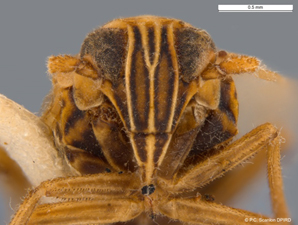Biosecurity threat, not present in Australia
Dicranotropis hamata (Boheman)
Caution
Many of the insects depicted on these pages are outwardly similar and you should not use photographs as the sole means of identification. These pages form part of a scientific key which will assist a trained entomologist to identify the species accurately.
Dicranotropis hamata (Boheman 1847)
Common Name: none known
Subfamily/Tribe: Delphacinae: Delphacini
Distribution: Dicranotropis hamata is currently found widespread in Europe, as well as scattered throughout Asia (Kazakhstan), the Middle East (Iran) and Africa (Tunisia, Algeria) (Bourgoin 2018; Guglielmino et al. 2016). It is not present in Australia.
Economic Status: Dicranotropis hamata feeds on grasses (Poaceae), with oats and maize being its most economically important hosts. It is a vector of Maize rough dwarf virus, Oat sterile dwarf virus, and Phleum green stripe virus. These three viruses are not present in Australia (Bremer 1991; Plant Health Australia 2011, 2014). Dicranotropis hamata was included on the Plant Health Australia (2015) contingency plan for exotic sap-sucking insects of grains.
Notes: There are 27 species of Dicranotropis globally (Bartlett 2018). Only one species of the genus, D. aristoxenus, occurs in Queensland but this species is likely to belong to a different genus (Bellis unpublished data). Dicranotropis fuscifrons was previously thought to occur in Australia but the original specimens were most likely misidentified and the species was removed from Australia’s checklist by Bellis et al. (2013). Females can be indistinguishable (Guglielmino et al. 2016), with differences between species predominantly based on male genitalia. In addition, D. hamata individuals can be either macropterous (winged) or brachypterous (reduced wings) further confusing identifications based solely on external morphology.

